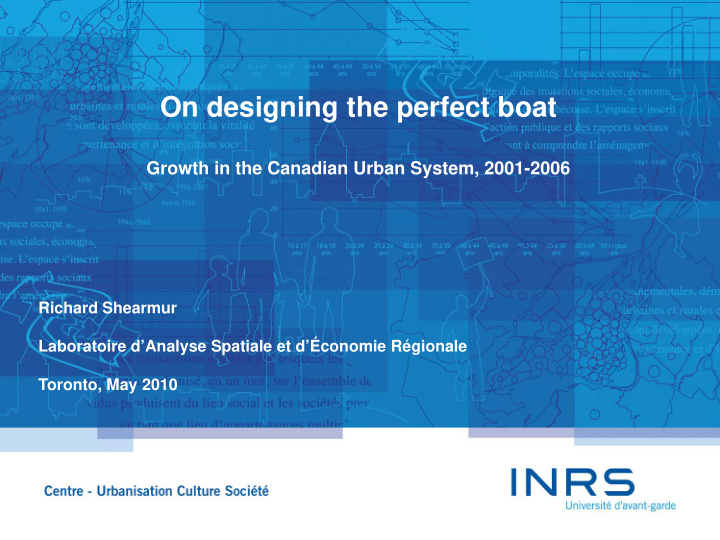



On designing the perfect boat Growth in the Canadian Urban System, 2001-2006 Richard Shearmur Laboratoire d’Analyse Spatiale et d’Économie Régionale Toronto, May 2010
Source: Warner Bros.
Gregory Wrona , http://www.photographersdirect.com/news/200807.asp
1- The neo-regionalist approach to innovation and growth - Regions are the ‘nexus of untraded interdependencies’ (Storper) - Innovation dynamics (linked to institutions, human capital, networks, collaborations) are principally local: the importance of proximity. - There is a connection between local innovation and local growth (endogenous growth theory). - Localities (cities) are conceived of as systems with their own internal innovation and growth dynamics, sometimes connected to others by pipelines but essentially with their own ‘buzz’.
2- A brief critique of this approach - Has tended to ignore knowledge about growth dynamics derived from city systems analysis (Pred, 1973; Pred & Tornquist, 1972). - Cities and regions are interconnected: thus what happens in one is connected with what happens elsewhere -Misapplies endogenous growth theory : - Can one reasonably expect smaller cities – and even metropolitan areas – to generate their growth dynamics internally? -In particular: - On what basis do we suppose that the employment and income benefits of innovation will be captured locally?
3- Another way of understanding city growth • City growth is partly attributable to : – local dynamics (neo-regionalism, or building boats) . • diversity, human capital, local institutions, local politics etc… – wider interdependencies with urban areas to which it is connected (city-systems, i.e. wider weather patterns). • regions, access to markets – global trends in the particular economic sectors which are found in the city (a- spatial industrial trends, , i.e. wider weather patterns) . • ressource booms, demand for automobiles, currency fluctuations – wider scale historic/political trends (path-dependency, , i.e. wider weather patterns). • e.g. opening up of west, NAFTA (North-South trade realignment)
4- An example of what this approach can tell us • Simple (meteorological?) model applied to Canada, based upon work by myself and colleagues (Shearmur & Polèse, 2007; Shearmur et al, 2007) • Growth is function of: – Local city size (proxy for agglomeration) – Location relative to markets (access to external agglomeration effects) – Location relative to metropolitan areas (centre/periphery) – Local specialisation (Jacobs v. MAR effects) – Local human capital – Industrial structure – Region (regional city-system effects and interdependencies) – Proximity to US border (US markets) – East-west dimension (historic drift to the west)
5- Model • Model is run with all explanatory variables • Outliers (observations which have strong individual effect on regression coefficients, based on Cook’s d) are eliminated • Independent variables are checked for multicollinearity (no collinearity problems, VIF is below 5) • Backwards selection process is performed to eliminate variables that are not significant (stay=90%) • Final model is checked.
6- Measures of growth • Employment growth • Earned income growth
Less wage pressure Wage pressure 7- Employment growth
Primary, 1st transform. and public services High-tech manufact. and high-order services Primary sectors Retail, leisure construction and real estate Public admin and information services Manufacturing
Employment growth 2001-2006: actual v. predicted
8. Earned income growth
Primary, 1st transform. and public services High-tech manufact. and high-order services Primary sectors Retail, leisure construction and real estate Public admin and information services Manufacturing
Growth in work income, 2001-2006: actual v. predicted
9. Conclusions • These results can be dismissed out of hand: – The weatherman / woman always gets it wrong ! – Naive positivism; – Vagueness of precise mechanisms at work; – They fail to integrate agency, institutions, local realities etc…; – They do not lend support to fashionable discourses such as ‘talent’, ‘territoriality’, ‘embeddeness’… – They rest upon (revisited) old theory (urban systems – especially Pred).
9-Conclusions • Or one can engage with the results: – What are the weather patterns and how do they (or don’t they) affect my boat? – Is the city region the correct scale at which to look for innovation systems? – To what extent do industrial clusters behave in a ‘Porterian’ way (localised dynamics) and to what extent do they reflect wider industrial trends (clusters as understood by Perroux(1949))? – Is it possible for the effects of local factors (such as human capital) to be captured locally, given the mobility of people, their involvement in non-local networks and multi-location companies? – Are innovation and local growth connected? Even if regional dynamics lead to innovation, does local innovation necessarily lead to local growth?
9. Conclusions • At the ISRN we have learned how to build, crew and organise boats very well: – We have dissected how local city dynamics affect innovation from a governance, talent and industrial perspective. • We still have little idea of what happens when the boats are put to sea. – We still do not really know to what extent and how this affects cities’ overall growth trajectories; – We still do not know what ELSE affects cities’ growth trajectories.
Selected bibliography (background to ideas expressed in this presentation): • On the weak connection between local innovation and local growth: – Shearmur, R., 2010, Like Oil and Water? Regional Innovation Policy and Regional Development Policy, Montreal: INRS working paper, http://www.ucs.inrs.ca/pdf/inedit2010_02.pdf • For the underpinnings of the growth model: – Shearmur, R., et M.Polèse, 2007, Do Local Factors Explain Local Employment Growth? : Evidence from Canada, 1971-2001, Regional Studies , 45.4, 453-471 – Shearmur, R., P.Apparicio, P.Lizion and M.Polèse, 2007, Space, Time and Local Employment Growth: An Application of Spatial Regression Analysis, Growth and Change , 38.4, 697-722 • On neo-regionalism and spatial analysis: – Shearmur, R., 2010, Innovation, Regions and Proximity: from Neo-regionalism to Spatial Analysis, Regional Studies (forthcoming) – Shearmur, R., 2010, Space, Place and Innovation: a Distance Based Approach, Canadian Geographer, 54.1, 46-67
Recommend
More recommend